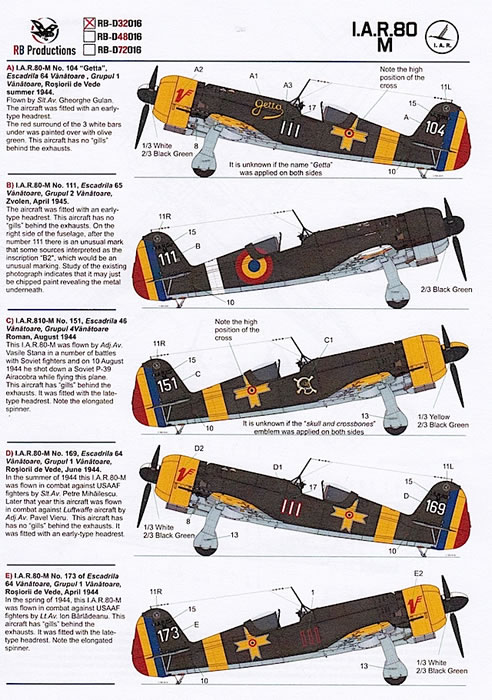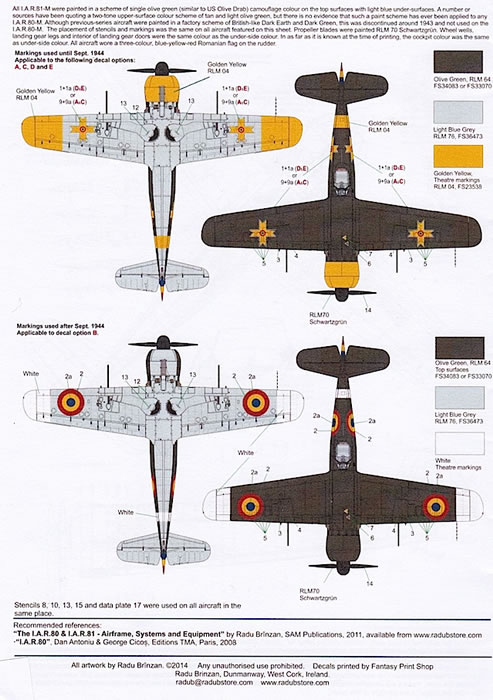IAR 80 M Decals

RB Productions, 1/32 scale
| S u m m a r y : |
Catalogue Number and Description |
RB Productions Item No. RB-D32016 - IAR 80 M Decals |
Scale |
1/32 scale |
Contents and Media |
1 x sheet of waterslide decals with markings for four aircraft; 1 x A4 double sided full colour instruction leaflet |
Price |
RB-D32016 – €14.75 each
Also available in 1/48 and 1/72:
RB-D48016 – €12.30 each
RB-D72015 – €9.85 each
Available online from www.radubstore.com |
Review Type |
First Look |
Advantages |
High quality decals; very comprehensive instructions. |
Disadvantages |
Not a disadvantage, but minor modifications are required to most available IAR 80/81 kits in order to achieve an IAR 80 M |
Conclusion |
This decal package will allow you to successfully and accurately model a less well-known IAR 80/81 variant. Highly recommended. |
Reviewed by Brad Fallen

Iliad Decals' 1/48 scale ANG Mustangs is available online from Squadron.com
Manufactured in 1943-44 the IAR 80 M was one of the final iterations of the IAR 80/81 series. It was less a new model than an upgrade of earlier IAR 80 and 81 airframes to match the armament of the definitive IAR 81 C: two 7.92mm machine guns and two 20mm MG 151/20 cannons. (The ‘M’ in the type designation stands for ‘Mauser’.) However the two types were not identical; amongst other differences the IAR 80 M had a marginally shorter fuselage and narrower wingspan than the IAR 81 C. I haven’t been able to discover how many IAR 80 Ms were produced, but given Romania’s deteriorating war situation at the time it may be that records are incomplete.

Kits of any IAR 80/81 variant are not plentiful, and for the IAR 80 M even less so. I’ve only been able to find one dedicated kit – the 1/72 Parc Models example – although there may be others. The good news for modellers wanting to replicate this subtype is first, the required modifications are reasonably straightforward, and secondly, Radu Brinzan has released these IAR 80 M decals in 1/72, 1/48 and 1/32 scale under his RB Productions label.

The 1/32 decals are being reviewed here, but all sets contain markings for the following five aircraft:
-
No. 104/“Getta”, flown by Slt.Av. Gheorghe Gulan of the Escadrila 64 Vanatoare, Grupul 1 Vanatoare, based at Rosiorii de Vede, Romania in summer 1944. This and the other featured aircraft (indeed all IAR 80 Ms, according to the instructions) were camouflaged in olive green upper surfaces and light blue lower surfaces. The engine cowling, lower wingtips and fuselage band were RLM 04 Yellow, the 1941-44 national insignia was carried in six places and the rudder wore vertical blue, yellow and red stripes in the style of the Romanian flag. Aircraft C, D and E were similarly marked.
-
No.111 of the Escadrila 65 Vanatoare, Grupul 2 Vanatoare, based at Zvolen, Czechoslovakia in April 1945. This aircraft wore post-1944 national roundels with a white fuselage band and lower wingtips.
-
No.151, flown by Adj.Av. Vasile Stana of the Escadrila 46 Vanatoare, Grupul 4 Vanatoare, based at Roman, Romania in August 1944.
-
No.169, flown by Slt.Av. Petre Mihailescu of the Escadrila 64 Vanatoare, Grupul 1 Vanatoare, based at Rosiorii de Vede, Romania in June 1944.
-
No.173, flown by Lt.Av. Ion Barladeanu of the Escadrila 64 Vanatoare, Grupul 1 Vanatoare, based at Rosiorii de Vede, Romania in April 1944.
As with previous RB Productions decal releases I have seen, the instruction sheet is of very high quality. This isn’t immediate at first glance – the illustrations aren’t large and the text font is small. However once you start reading it’s clear that Radu has provided a huge amount of information on both the specific airframes and the IAR 80 M in general.
On the front page of the instructions individual aircraft are covered by full colour port or starboard profiles, accompanied by a block of text outlining the airframe’s history and key features. Arrowed captions point out decal numbers, paint colours and unique or unverified markings.
On the back page are two dorsal and ventral plan views – one for option B’s post-1944 markings and the other for options A, C, D and E. Again these are in full colour, and accompanied by paint swatches citing US Federal Standard and RLM colours.

Sandwiched in between are the jewels of these instructions – descriptions of the rationale behind the development of the IAR 80 M and the modifications required to achieve this version in model form. The text is accompanied by four-view grey scale illustrations that break the airframe down by fuselage and wing station, with cross-section views of the wing at each station and (again) key IAR 80 M features clearly marked. These include comparative drawings of the IAR 80 M’s ‘short nose’ fuselage and the ‘long nose’ fuselage of some other variants, and the differences between long and short span airframes and early and late headrests.
The decals are similarly impressive. They are by Fantasy Printshop and appear to be perfectly produced, with excellent density and registration. To assist with the latter the blue centres in each style of marking have been printed separately. This will mean a slower application process because you’ll need to make sure the main decal is perfectly dry before you apply the blue centre, but the trade-off will be perfectly aligned roundels.
This release is an interesting choice for RB Productions given the paucity of IAR 80 M kits on the market. The modifications required to convert an IAR 81 C are reasonably straightforward, although I’d recommend studying the instructions carefully before you start cutting. Once you’ve done this work, the decals will deliver a beautiful and accurate finishing touch to your model that may well have people guessing as to which IAR 80/81 variant it represents.
Highly recommended.
Thanks to RB Productions for the review sample.
Text and Images Copyright © 2015 by Brad Fallen
This Page Created on 15 June, 2015
Last updated
15 June, 2015
Back to
HyperScale Main Page

|
